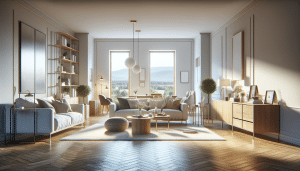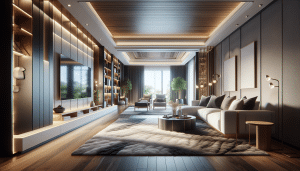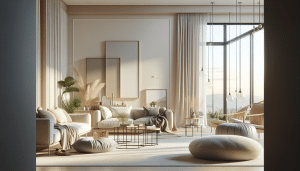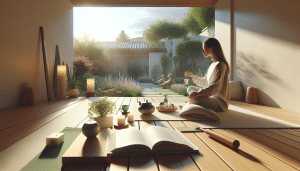How You Can Upgrade Your Living Space Easily
Jessica White September 16, 2025
Transforming a home environment doesn’t require major renovations. With strategic design ideas, small lifestyle tweaks, and creative organization, you can enhance comfort, aesthetic appeal, and efficiency. This guide explores practical home upgrades that help achieve a fresh look while supporting your well-being.
Embracing Minimalism for a Refreshing Atmosphere
Minimalism goes beyond merely getting rid of excess belongings. It invites mindfulness about what truly adds value to a space. By prioritizing essentials, rooms feel more open and less cluttered, which enhances both physical and mental comfort. Even subtle decluttering, like organizing shelves or clearing countertops, creates a calming effect. Embracing minimalism also makes cleaning simpler and contributes to a healthier home environment—a win for everyday living.
Many people feel overwhelmed by their possessions, and minimalism counters that by focusing on quality over quantity. Start by donating items that are rarely used or serve no clear purpose. You don’t have to achieve perfection overnight; minimalism is a gradual process. Begin with one room or even a single closet, noticing how the freed-up space impacts your mood and productivity. Each step creates noticeable improvements in energy and clarity, making your home a sanctuary.
A minimalist living space supports wellness as well. Research shows that cluttered environments can increase stress and decrease focus. Curated, tidy spaces foster a sense of calm and accomplishment. Choose furniture and décor that blend function with simplicity—opt for pieces that serve multiple roles or offer hidden storage. This approach not only boosts your home’s visual harmony but also encourages mindful consumption and savings in the long run (Source: https://www.apa.org/news/press/releases/2019/01/organizing-clutter).
Maximizing Small Spaces with Smart Storage Solutions
Optimizing small spaces is all about creative storage. Vertical solutions—think shelves, hanging organizers, or mounted cabinets—draw the eye upward and make use of often-overlooked wall area. Multi-functional furniture, such as beds with drawers or ottomans with internal compartments, offer hidden places to stash items. Open shelving can also showcase favorite belongings in an organized manner, balancing accessibility with style.
Utilizing underutilized spaces, like the backs of doors or corners, can create more storage without sacrificing square footage. Hooks, baskets, and modular systems add efficiency to entryways, kitchens, or bathrooms. For renters or those seeking non-permanent upgrades, adhesive hooks and stackable crates provide flexibility and adapt to changing needs. Smart storage increases both functionality and aesthetic, avoiding crowded or cramped feelings in your home.
Effective organization often centers around routine. Establishing daily or weekly tidying habits ensures spaces stay functional and attractive. Label bins for quick identification or employ color coding for family members. Many professional organizers suggest revisiting storage systems each season, adjusting for evolving lifestyles. Investing in smart storage pays off through time saved, reduced stress, and improved quality of life (Source: https://www.napo.net/page/WhyHire).
Personalizing Your Decor for Unique Comfort
Home isn’t just a place to live; it’s a canvas for self-expression. Personalizing décor allows for emotional connection and daily inspiration. Incorporating personal mementos, favorite colors, or meaningful art pieces fosters a sense of belonging. Layering different textures—like cozy throws, natural wood, or tactile rugs—adds warmth and personality, making spaces welcoming for both residents and guests.
Even on a budget, swapping out pillow covers, adding removable wallpaper, or updating lampshades can transform the look and feel of any room. Plants, whether large or small, offer a lively touch and purify air at the same time. Experiment with arrangements or groupings to match changing moods and seasons. Allow creativity to guide choices, resulting in décor that truly resonates.
The power of personal stories reflected in design shouldn’t be overlooked. Gallery walls featuring family photos, travel souvenirs, or DIY crafts provide ongoing joy and conversation starters. Changes don’t have to be permanent—rotating artwork or rearranging furniture can refresh energy without great expense. Ultimately, intentional décor choices support emotional wellness and pride in your living space (Source: https://www.houzz.com/magazine/how-to-get-the-most-from-art-at-home-stsetivw-vs~578632).
Leveraging Lighting to Highlight Your Home
Lighting isn’t just functional—it shapes mood, enhances décor, and can even support good health. Natural light brightens rooms, reduces energy costs, and positively affects circadian rhythms. Positioning mirrors to reflect sunlight or choosing light-colored curtains amplifies existing daylight. In dimly-lit areas, layering ambient, task, and accent lighting adds depth and drama, ensuring every corner feels intentional and inviting.
Smart lighting solutions, like LED bulbs or programmable fixtures, help tailor environments for different times and activities. Warm lighting in living rooms encourages relaxation, while brighter, cooler tones support focus in work areas. Portable lamps, fairy lights, or under-cabinet strips introduce softness and a touch of whimsy. Combining different light sources allows for personalized scenes adaptable to any mood or event.
Maintenance and quality matter, too. Regular cleaning of windows and light fixtures maximizes brightness. Investing in energy-efficient options lowers utility bills over time and supports environmental sustainability. Upgrading a single lamp or changing bulb colors offers immediate impact. Thoughtful lighting design elevates style and supports healthier, more enjoyable routines (Source: https://www.energy.gov/energysaver/save-electricity-and-fuel/lighting-choices-save-you-money).
Exploring Smart Home Trends for Modern Living
Smart home technology is transforming everyday living. Voice-activated assistants, automated thermostats, and advanced security cameras foster convenience and peace of mind. Devices can streamline chores, automate schedules, and improve resource efficiency. Integrating technology doesn’t have to be complex—many devices are plug-and-play, syncing through user-friendly mobile apps. The result is greater ease tailored to the way people actually live.
Popular smart upgrades include energy monitoring systems, app-controlled lighting, and smart speakers. Each enhances comfort and efficiency. Energy monitoring pinpoints consumption, helping homeowners make eco-friendly choices. Smart plugs and bulbs adjust remotely, ensuring lights aren’t accidentally left on. Digital assistants provide reminders, music, and even wellness check-ins, supporting balance in busy lives. Security features like smart doorbells or motion detectors add a digital layer of safety to any environment.
Privacy and adaptability are essential in modern home tech setups. Choose reputable brands with strong data protections, and regularly update devices to maintain security. Try starting with one or two smart gadgets before expanding further. Even simple enhancements, such as programmable coffee makers or wireless charging stations, elevate convenience instantly. Staying updated on trends can inspire future upgrades that blend technology and comfort seamlessly (Source: https://www.cnet.com/home/smart-home/smart-home-guide/).
Incorporating Green Design and Wellness Elements
Green design isn’t just a passing trend—it’s an approach that improves well-being while benefiting the environment. Integrating natural materials, indoor plants, and eco-friendly products reduces toxins and supports cleaner indoor air. Bamboo furniture, organic linens, or non-toxic paints all contribute to a healthier living space. Prioritizing local or upcycled décor lowers environmental impact and brings distinct character to a home.
Wellness-inspired design touches—like creating quiet reading nooks or meditation zones—help reduce stress. Soft natural lighting, soothing colors, and ergonomic furniture support both body and mind. Purifying indoor air with spider plants or peace lilies adds living décor while removing airborne pollutants. By blending biophilic elements with practical upgrades, it’s possible to shape a home that promotes resilience and wellness.
The benefits of eco-consciousness extend to financial savings as well. Simple changes, like using programmable thermostats, weather-stripping doors, or energy-efficient appliances, lower utility bills. Planning upgrades with sustainability in mind may qualify for incentives or rebates through local programs. A green home isn’t only stylish; it’s future-friendly and nurturing for everyone within (Source: https://www.epa.gov/greenhomes).
References
1. American Psychological Association. (2019). Why messy homes affect your mind. Retrieved from https://www.apa.org/news/press/releases/2019/01/organizing-clutter
2. National Association of Productivity & Organizing Professionals. (2023). Why Hire a Professional Organizer? Retrieved from https://www.napo.net/page/WhyHire
3. Houzz Editorial Team. (n.d.). How to Get the Most From Art at Home. Retrieved from https://www.houzz.com/magazine/how-to-get-the-most-from-art-at-home-stsetivw-vs~578632
4. U.S. Department of Energy. (n.d.). Lighting Choices to Save You Money. Retrieved from https://www.energy.gov/energysaver/save-electricity-and-fuel/lighting-choices-save-you-money
5. CNET. (n.d.). Smart Home Guide. Retrieved from https://www.cnet.com/home/smart-home/smart-home-guide/
6. U.S. Environmental Protection Agency. (n.d.). Green Homes. Retrieved from https://www.epa.gov/greenhomes








